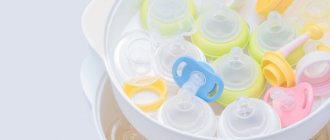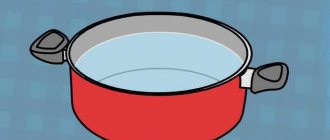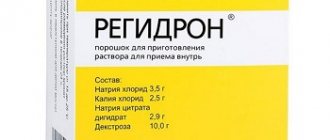No need, that's all!
Pediatric dentists were the first to worry: prolonged use of a pacifier leads to an incorrect bite (experts call it an open bite). The incisors grow forward and do not close, the child’s face becomes deformed, acquiring an elusive resemblance to a rabbit’s face. In addition, a nipple that is too hard (without an air release valve at the base) or too large disrupts the development of the jaws. Today, pacifiers are produced in three sizes - for children up to 4 months, up to a year and up to 1.5 years. However, it is better not to use the latter! Speech therapists also complain: due to dental problems caused by too close friendship with the pacifier, the child has difficulties in pronouncing many sounds. Neurologists are also unhappy: in their opinion, the pacifier inhibits the baby’s mental development. Experts in childhood infections join the general chorus: the older the child, the more difficult it is to keep the pacifier clean. If he already moves around the apartment independently, begins to walk at home and on the street, mommy may not notice that the baby dropped the pacifier, and then picked it up and put it in his mouth. Or he simply pulled it out, twirled it in his dirty hands and sent it back. And then parents and doctors are perplexed: why does the baby have an intestinal disorder? The most radical opponents of the pacifier argue that a child is quite capable of doing without it, that adults themselves impose on him the bad habit of constant sucking, which they then cannot wean a grown child from. Indeed, some children immediately categorically reject the pacifier, and the question immediately goes away on its own. However, most babies still make it clear that they need it, and if it is not there, they begin to suck their own fist, tongue, sponge, cheek, tip of a diaper, collar of a blouse, and they do this mainly when they feel uneasy...
Tips for using a pacifier
- Don't give your baby a pacifier on every occasion. Wait until the baby really needs it. For example, with colic, stool problems, fever or other health problems. In addition, there are many ways to relieve a baby from discomfort. How to help a newborn with colic, read here. It is important that sucking a pacifier does not become a habit!;
- Do not use the pacifier frequently or for long periods of time. Komarovsky does not recommend using a pacifier before bed. To make the baby fall asleep, it is better to give the baby the breast and rock the baby in your arms.
- Do not give your baby a pacifier until you have established breastfeeding;
- Buy pacifiers in specialized stores and pharmacies, preferably after consulting a pediatrician. Remember that it is important to choose the right shape, size and material of the product. The baby’s bite and well-being depend on the choice;
- Make sure to keep the pacifier clean. Boil and sterilize the item regularly. Do not lick the pacifier if it has fallen on the floor! This violates hygiene standards and increases the risk of developing an infectious disease in the baby;
- Check pacifiers regularly for integrity. Cracks and holes collect germs! If there are defects, be sure to replace the product with a new one;
- Avoid immersing your pacifier in sugary foods and drinks, as they may cause allergies and digestive problems. In addition, sweets lead to tooth decay;
- It is better to wean your baby off the pacifier before one year of age. After a year it is more difficult to do this.
Give, but with caution
Modern pediatricians have rehabilitated the pacifier (albeit with certain reservations and restrictions). This happened for many reasons, the main one of which is that by eradicating the dummy as the source of some problems, we unwittingly create others, sometimes even more dangerous and insoluble. You can’t escape the age-old experience - a pacifier really calms a child. This happens because nature has provided him with a powerful sucking reflex. When the baby sucks, he fully concentrates on this activity, distracted from any external stimuli and unpleasant sensations. So, truly, the shortcomings of a pacifier are a continuation of its advantages. It is this concentration, literally on sucking, that makes the baby less interested in others, reduces activity, and makes wakefulness less productive. In addition, you want to constantly reproduce this comfortable state; the craving for it increases and becomes habitual. The child already sleeps only with a pacifier, and if he accidentally drops it in his sleep, he begins to worry and cry. Thus, instead of peace, we get the exact opposite - irritation!
A pacifier saves you from death
Doctors who defend the pacifier claim that it not only calms and distracts from pain and whims, but also helps the formation of emotions. Psychologists have noticed that, for example, girls who grew up without a pacifier become cold and inattentive mothers to their children. Why, the pacifier, according to scientists, saves children’s lives, in the literal sense!
Keeping it in the mouth during sleep prevents vomit and masses from entering the respiratory tract during regurgitation and prevents the tongue from retracting. In addition, sleep when sucking on a pacifier is not so deep, and in the event of a sudden stop in breathing (apnea), the baby will be able to wake up in time. In contrast to orthodontists who say that the pacifier is the key to an incorrect bite and jaw formation, other “dental” doctors are confident that the bite will be perfect when using the correct pacifier.
Problems of artificial people
It has been noticed that it is easiest for babies who have been breastfed for up to a year to part with the pacifier. To extract milk from it, you need to work for at least 15-20 minutes - during this time the baby more than satisfies the need for sucking. The baby practically drinks the mixture from the bottle in one gulp: it seems like he’s already full, but still hasn’t gotten enough! But the sucking reflex is the main one in children in the first months of life; it overrides all others. By not giving him his due, you are setting the stage for problems, including increased excitability and the habit of thumb sucking. Later it develops into biting nails, sucking strands and eating hair, a pathological love for chewing gum and an addiction to cigarettes. It doesn’t occur to a person to connect these bad habits with early weaning from the pacifier, but psychologists are convinced that this is so!
Benefits of a pacifier
The pacifier satisfies the sucking instinct - dominant in infants - in cases where the mother is forced to leave, or when the baby is transferred to artificial feeding.
But the pacifier must be chosen correctly so as not to interfere with the formation of a correct bite.
Premature babies are often born with a weak sucking reflex.
Therefore, in the first days after birth, they are fed through a tube. These babies need to be prepared for bottle feeding. Using a pacifier will help your baby develop a sucking reflex and move on to bottle feeding.
American pediatricians claim that pacifiers have saved children's lives more than once. A comparative analysis showed that in developing island countries, where mothers are more likely to use pacifiers, the percentage of cases of sudden infant death is much lower than in the United States. This is explained by the fact that pacifiers prevent the tongue from retracting and breathing stops during sleep, and also help the baby not to choke in case of regurgitation.
A pacifier can be an excellent helper in cases where the baby needs to be distracted: at a doctor’s appointment, during vaccinations, with colic in the stomach.
During suckling, the hormone cholecystokinin is released in the baby's body.
This is a kind of antidepressant that calms the child and helps him fall asleep.
It also starts digestive processes and even relieves pain.
A pacifier can also serve as a kind of lock for a noisy mouth. If a baby cries on the street, he runs the risk of catching cold air. A pacifier will help prevent such situations, and during the first attempts to learn swimming, a child with a pacifier in his mouth will not drink water.
Dr. Komarovsky’s opinion: “If the pacifier does not interfere with breastfeeding and makes the mother sleepy and rested, then I’m for it! Mom to satisfy the sucking reflex in the 21st century is wrong. Mom - for nutrition!”
We act according to the situation
Give a breastfed baby a pacifier only in special cases (sick, tired, not feeling well, can’t sleep). Don't offer a pacifier when you can do without it. And most importantly, help the baby part with her in time! The right moment comes from the 4th to the 6th month: after 3 months, the child is no longer tormented by intestinal colic, he becomes calmer and reaches for the pacifier less. If you can give up the pacifier now, that’s just great; if not, you can wait a little longer. The time is just around the corner when teething begins: at such a moment, the child has every right to demand a pacifier as an effective sedative. In any case, parting with the pacifier should happen in the first year of life, unnoticed and by good agreement - without the slightest violence against the baby! Be sure to offer your artificial baby a pacifier after feeding to satisfy his sucking reflex. When you get tired, take it out of your mouth. Do not eliminate the pacifier from use too early - wait at least until 6 months, and then begin to slowly wean the baby, focusing on the individual need for sucking. Usually from this time the sucking reflex begins to fade away - it’s time to switch the child’s attention to new interesting and more useful activities, and not to gag his mouth with a pacifier until he is 1.5 or even 2 years old!
What's inside?
White pacifiers are made of silicone, yellow ones are made of latex. The latter sometimes causes allergies, which can easily be mistaken for thrush. If your baby doesn’t get better despite treatment, try replacing the latex pacifier with a silicone one! At the Scientific Center for the Health of Children and Adolescents, all pacifiers are checked for the presence of toxic substances, including the N-nitrosamine element, which may be part of latex. If its content is higher than the permissible limit (10 mcg/kg), the batch of teats is immediately destroyed. Among the certified nipples that hit the pharmacy shelves, there are no dangerous ones!
Secrets of choice
- Find out from your pediatrician or pediatric dentist which pacifier is suitable for your baby - cherry or drop?
- Buy pacifiers in pharmacies or large stores, where the quality of the product is guaranteed.
- Study the information on the packaging: the child’s age should be indicated there.
- Check for cracks or bubbles in the nipple, due to which it may not withstand boiling and will quickly become unusable.
- Consider whether the restrictive ring will be too bulky for a child's face: it should not rest against the nose!
- Make sure there is an air release valve at the base of the nipple.
We choose a pacifier together
Here we come to which pacifier to prefer. I won't talk about their design. Now there are both diamond-encrusted and gold versions. We are more interested in the internal content and usefulness.
First of all, choose a product according to age. Carefully inspect the packaging and the pacifier itself. There are no cracks or strange bubbles - it means it’s made well and won’t fail soon. Pay attention to the air outlet valve.
Now about the forms. If your baby's lower jaw is slightly underdeveloped, buy a pacifier with a slanted top. When grabbing it, the baby will have to work hard and push out the lower jaw. If the bite is normal, choose a cherry-shaped pacifier.
Doctors recommend choosing silicone nipples, as they are hypoallergenic, last a long time and do not deteriorate when boiled, unlike latex ones. However, the good old rubber pacifiers should not be written off. It is these that pediatricians recommend using when babies are teething.
The last thing you think about is the appearance of the nipple. Color and design are up to your taste, the main thing is that the baby is comfortable. To protect against falls, purchase a plastic chain with a clip. With its help, the pacifier can be easily attached to the baby’s blouse pocket, and if he drops it, he will quickly catch it.
We wean correctly
The baby is already a year old, but he won’t part with his pacifier? Persuade the baby to give it to the crow or bunny. When he starts looking, say: “Well, you remember, yesterday we gave your pacifier to the bunny mother, she just gave birth to a little bunny.” Some mothers smear the pacifier with mustard, rub it with garlic... This is not good: the baby can burn his mouth, not to mention mental trauma! Resort to a trick: cut off a little from the tip of the pacifier every day - when it is no longer possible to suck on it, the child will throw it away. And if he suddenly tries to find a replacement for her, he will start sucking on a finger or the edge of the sheet before going to bed, gently release them from his mouth and distract the little one with a lullaby.











